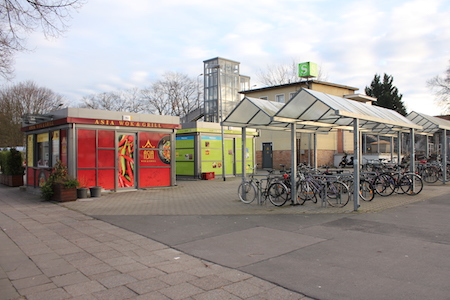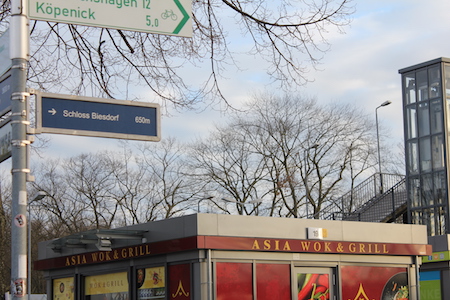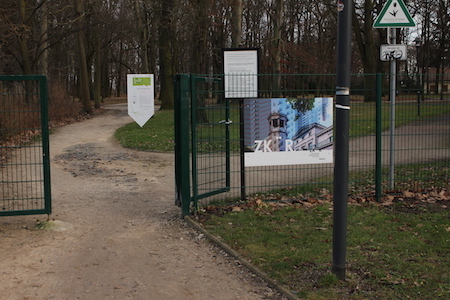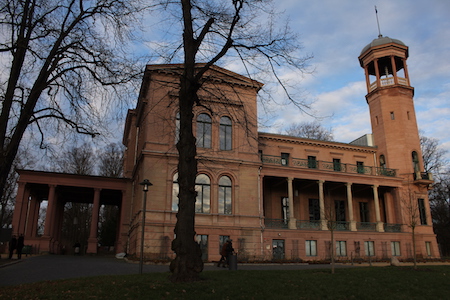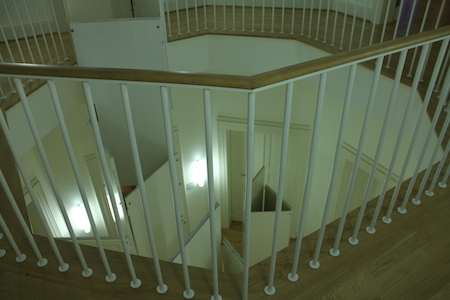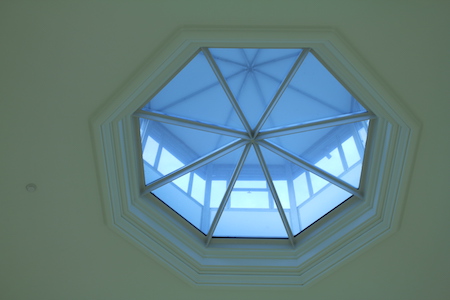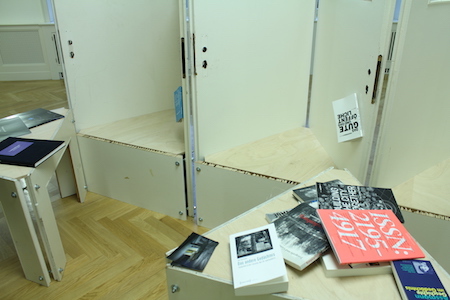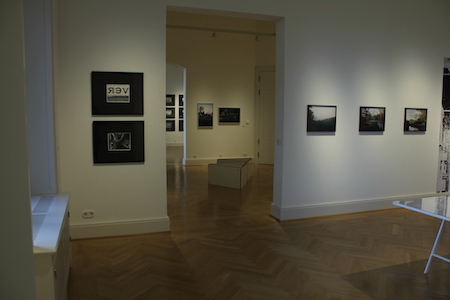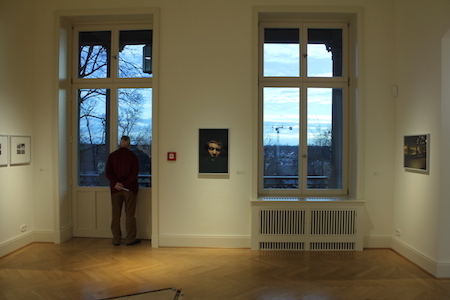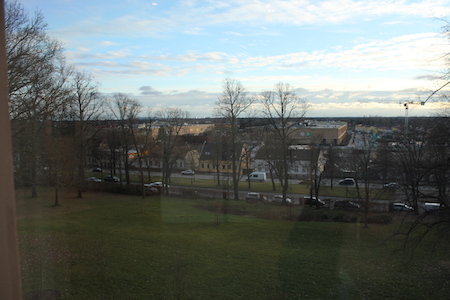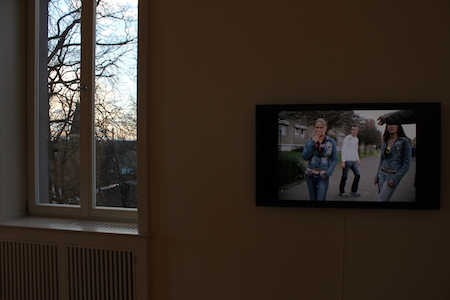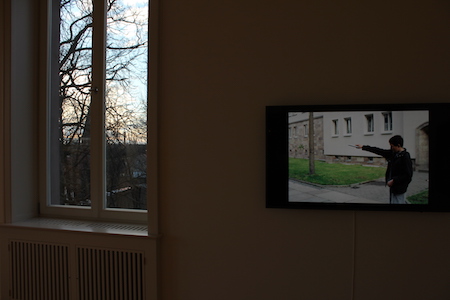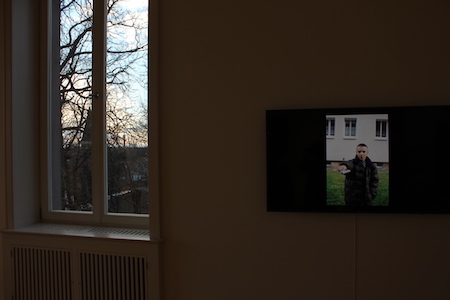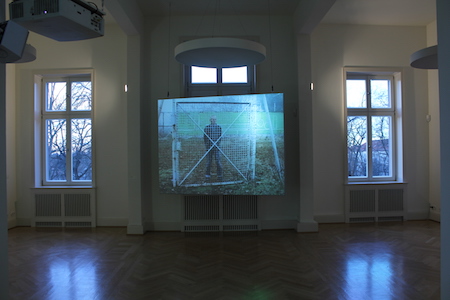Blickverschiebung
You might remember the post “Before and After” which was part of a series of posts, which were documenting the demolishment of a pub/restaurant/dancehall in the Berlin neighbourhood of Biesdorf, which belongs to the Berlin district of Marzahn-Hellersdorf.
The above image shows the train station S-Biesdorf. The former restaurant was located right behind the back of the fotographer. If you look at the post you should be able to assemble the space situation.
A little recap: In the post “Death of a pub”, which belonged to this “demolition series”, it was described that the district denied to jump in and buy the pub/restaurant/dancehall in order to avert its demolition. The question to do so was asked by me in front of the parlament of Marzahn-Hellersdorf. My estimated price for the pub including a basic renovation was about 500 000 Euros. Moreover in a kind of “townhall meeting” organized by the then head of the department for construction and city development and his party, the CDU, I asked the question why the department of city development and in particular he, Mr. Gräff finds that supporting the running costs of the castle which was right next to the former pub/restaurant with 500.000 Euros/year is considered to be more important than buying the pub/restaurant. The answer was (recorded from my memory):
Well – one can have different opinions about the pub/restaurant and I had another opinion than you. Like there are old ladies for whom it is easier if there are shops in the vicinity. Furthermore 500. 000 Euro is still a lot of money and one can use this money better for e.g. preschools and schools.
So with this “answer” he of course did not answer my question. Moreover in this “townhall meeting” I was not able to ask further questions in front of the public.
That is of course it is unnecessary to mention that I haven’t seen many old ladies in the new gastromomy spaces “Schranke” and “Dönerhaus”, which are there now instead of in the old pub/restaurant/dancehall.
And yes – he is right with the point that money is needed for schools, in part because there is currently a lot of new housing being built in Berlin, which has no counterpart in terms of infrastructure, i.e. schools, doctors, etc. (I come back to this later) – BUT of course my question was not about all this but about the districts subsidies for the running costs of the castle. This question was in particular not without brisance, since he was then a member of the supervisory board of the company Grün Berlin GmBH, who got the offer to run the castle with those subsidies.
So what happened with the castle in the mean time?
The company Grün Berlin GmBH who is also the company who organized the big garden exhibition IGA in Marzahn-Hellersdorf (some comments to that also here) established there a “centre for Art and Public Space”, whose room rent was however so expensive that it was not possible to organize a Tango evening there.
Now -after one and a half years- Grün Berlin GmBH announced rather surprisingly that they are going to stop to run the castle. On their wesbsite they write:
Trotz geringer finanzieller Ausstattung und hohen Betriebskosten hat die Grün Berlin GmbH das betriebliche Budget in den Jahren 2016 und 2017 einhalten können. Zugleich hat die Grün Berlin GmbH auf die zu hohen Einnahmeerwartungen seitens des Bezirkes hingewiesen. Diese Einnahmeerwartungen hätten sich in den kommenden Jahren deutlich
erhöht und zu einer unverträglichen Kommerzialisierung des Kunstortes geführt, die in Widerspruch zu den geltenden Förderrichtlinien steht – eine Entwicklung, die die Grün Berlin GmbH nicht verantworten kann.
translation without guarantee:
Despite a small financial budget and high running costs Grün Berlin GmH was able to maintain the budget for the years 2016 and 2017. In the meantime Grün Berlin GmBH was able to point out that the income expectations of the district are to high. Those income expectations would have distinctively grown for the upcoming years and would have led to an incompatible commercialization of this art location, which is in conflict with the prevailing subsidy guidelines – a development which can’t be accounted for by Grün Berlin GmBH.
So in the following let’s have a look at the castle, i.e. at the “Schloss Biesdorf” and the now basically closed “Centre for Art and Public Space”, the Biesdorf ZKR.
The entry to the castle park with the sign of the ZKR.
From the museumsportal website:
“ZKR – Centre for Art and Public Space aims to explore the complex interplay between art, architecture and public space. As a cultural project of the publicly-owned Grün Berlin GmbH, the ZKR displays art in both an urban and an environmental context. Changing exhibitions display international contemporary art alongside art from the former GDR, thus revealing unexpected associations between the artistic positions of the different eras.”
The castle which hosted the ZKR was built around 150 years ago by Heino Schmieden for a familiy of landowners, then later acquired by the Siemens Family and then finally acquired by the city of Berlin. It was recently renovated -partially with EU funding. The renovation included the reconstruction of the upper floor, which was destroyed due to a fire. The octagonal tower is giving the villa/castle a rather distinctive look.
The tower is not the only octagonal shape. Due to the renovation the public is now able to see the inner octagonal yard -a rotunde- with an octagonal cuppoloa. In the ground floor you can see a sculpture with doors, which is apparently from an art collective called freiraumlabor.
I was though shocked, after I saw on this image that the sculpture hides a rather expensive looking marquetrie. As I said, I think this marquetrie was not visible beforehand and so it now contributes to this very different look the castle has now. What a difference to previous times, when it was still a community center!
There is a room in the castle where Laleh Torabi and coworkers tried to illuminate the complicated history of Schloss Biesdorf. The artwork is called 1868.
There is also a door sculpture which provides seats so that people may study the info material. It is in the room where formerly the “Kasperletheater” and other cultural events took place.
Here a view into the gallery space in the upper floor.
The gallery currently hosts the exhibition “Blickverschiebung”, translated as “Shifting perspectives.” From museumsportal:
The exhibition “Shifting Perspectives” focuses on the decaying landscapes and urban structures of East Germany, from the GDR and the post-reunification era to the present.
Instead of looking at the pictures, one can though get a great first hand view onto the “decaying landscapes and urban structures of East Germany” by simply looking through the windows.
No this is not right after WWII. This is what you see now if you look south through the windows. In the front you see the 4 to 6 lane broad highway B1. The highway is bordered in the south by remnants of the old medieval village of Biesdorf. Right behind the houses there is currently a vast empty area, which extends to two big blocks, which form a shopping centre, called Biesdorf center. The vast area in between is sought to be soon filled with appartment buildings with an emphasis on council housing. The village and the manor that had been there and in the vicinity has been completely erased – partially through the wars, the GDR times but also a lot in recent times. According to this article there were more historical buildings in Germany been destroyed after 1945 than in WWII.
The highway is here separated by a traffic island. On this island but more towards the west (not in the image) there is the medieval church of Biesdorf. As you can see in this image it is rather “frequented”.
Here I tried to take a foto of the church, unfortunately it is always a bit obstructed. Accidentally in the background there are fotos of a slide show by Tobias Zielony with apparently images of young people from Ukraine, who very apparently had quite mixed feelings about the fotographer.
The mixture between the fotographies and images and the surrounding building led sometimes to astonishing compositions. Here an accidental shot from what actually was a video with a rather rapid film structure in the ZKR exhibition.
As far as I know it is currently not really clear what is going to happen to the castle, apart from the fact that the local district gallery “Galerie M” will move in. It seems the district was rather surprised by the sudden denouncement of Grün Berlin GmbH. It is also not clear to me where the high running costs come from. From the artists tags of the fotography exhibition it seemed that the artworks were (freely?) donated to the exhibition, but I might be wrong. It would be interesting and rather important to understand this better.
Anyways it seems all this might not be the end of ZKR. That is the website of Grün Berlin GmBH currently says:
Die Grün Berlin GmbH beabsichtigt, das ZKR – Zentrum für Kunst und öffentlichen Raum an neuem Standort und mit neuem Ansatz als Produktions- und Diskussionsort für das Zusammenspiel von künstlerischen Projekten und Fragen der Stadt- und Landschaftsplanung ab 2018 weiterzuführen.
translation without guarantee:
The Grün Berlin GmbH plans to continue the ZKR – Centre for Art and Public Space at a new location and with a new ansatz as a location for the production and the discussion of artistic projects and questions in urban and landscape planning.
